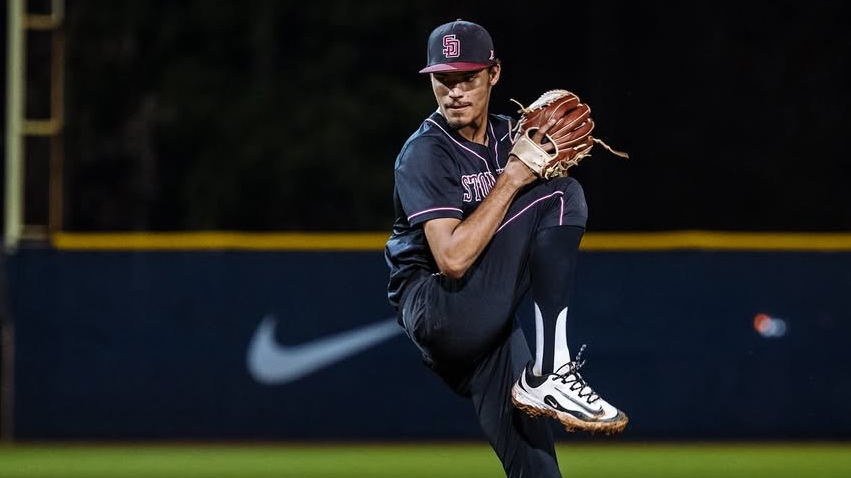
Gio Rojas – RHP | Age: 18 | Marjorie Stoneman Douglas HS | Committed to University of Miami
Mechanics
Gio Rojas works from a low ¾ to near sidearm arm slot reminiscent of Sean Manaea. This slot naturally reduces stress on the elbow and lowers the risk of UCL injury that often leads to Tommy John surgery. With so many hitters accustomed to overhand or standard ¾ slots, Rojas’ lower release point disrupts timing and sightlines — similar to the effect Sean Manaea created during his strong second half and postseason run with the Mets in 2024.
Rojas also features a high leg kick comparable to Aroldis Chapman. Out of his windup, he briefly hides the ball behind his back before delivering it in a slingshot-like motion toward the plate. This adds deception, making it difficult for hitters to pick up the baseball or spin until just before release — shrinking their reaction time to decide whether to swing.
There is room for refinement in his lower half. At times, Rojas keeps too much weight on his back leg, limiting velocity. A firmer, more aggressive plant of his front (right) leg would allow him to better transfer energy toward the plate, helping his fastball velocity play more consistently in the upper range. Increased velocity paired with his ability to locate would lead to more swings and misses and enhance the effectiveness of his off-speed pitches by widening the velocity differential.
Despite mechanical areas to tighten, Rojas repeats his delivery well and maintains the same arm slot across all pitches, minimizing the risk of tipping.
Comps: Sean Manaea (arm slot), Aroldis Chapman (leg kick)
Pitch Types
Rojas features a three-pitch mix of a fastball, slider, and changeup. As referenced above, his leg kick is significant, but inconsistent weight transfer causes his fastball to vary between 92–93 mph, touching 96–97 mph. With improved lower-body mechanics similar to Chapman’s, he should be able to consistently sit in the higher range and maximize the impact of his secondary pitches.
His slider plays effectively against both left- and right-handed hitters due to its late, sharp break. Out of the hand, it resembles a fastball that will miss the zone before darting late. Against right-handed hitters, he commands it well to the inner half, often freezing hitters who expect it to stay off the plate. Once establishing that he can land it for strikes, he can expand off the plate to generate chases, whiffs, or jamming hitters resulting in weak contact. Versus left-handed hitters, the pitch works toward the outer half, leading to chases and weak ground-ball contact when put in play.
Both his slider and changeup are designed to play off his fastball. They mirror each other well out of the hand, enhancing deception: the slider breaks late and horizontally, while the changeup fades and drops vertically. His lower arm slot enhances this tunneling effect, as all three pitches share a similar release point and early trajectory.
Rojas’ success stems from his command and the quality of his secondary offerings, allowing him to induce soft contact consistently. His repeatable delivery and ability to locate to all quadrants should appeal to evaluators. While further development is needed as he faces stronger competition, he has shown coachability — a trait as valuable as raw talent when projecting a player’s future.
Conclusion
Rojas is committed to playing Division I baseball at the University of Miami next year. His high school, Marjorie Stoneman Douglas, has produced multiple MLB players, including Anthony Rizzo and Jesús Luzardo, and Rojas will benefit from building on that foundation in the ACC. The Miami coaching staff will have the time and structure to refine his mechanics and sharpen his pitch mix. College baseball offers a more suitable progression for him than entering pro ball immediately, as the talent gap is less drastic.
While the long-term plan is for him to develop as a starting pitcher, his three-pitch feel and unconventional arm slot could also make him a valuable weapon in the back end of a bullpen. His look would provide a strong contrast after a conventional ¾-slot starter. In either role, he has the tools to succeed — and college is the right next step to unlock his potential.



0 Comments